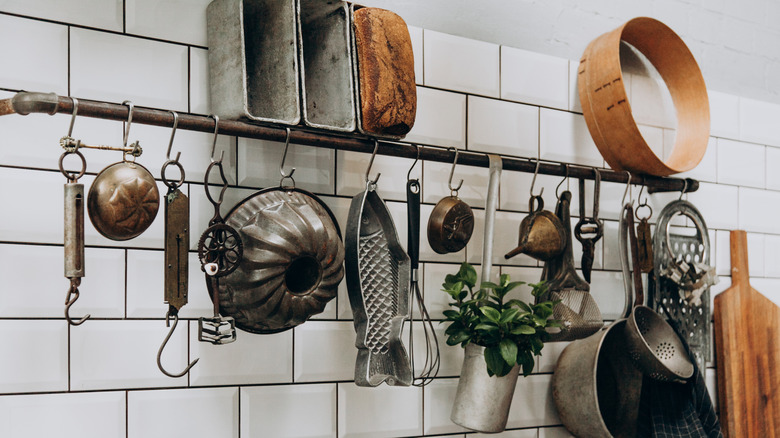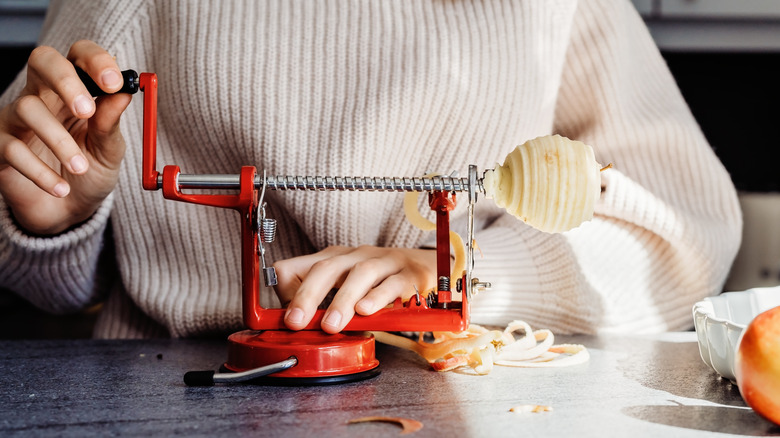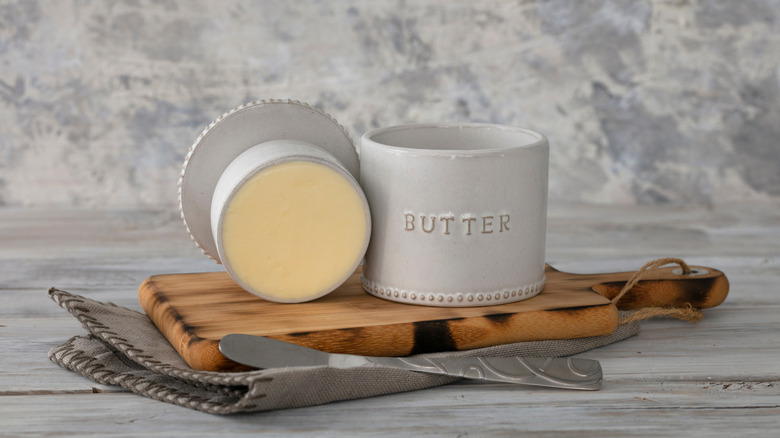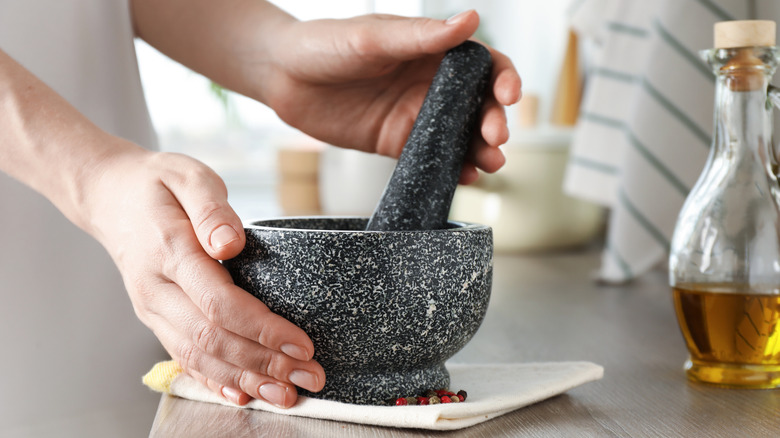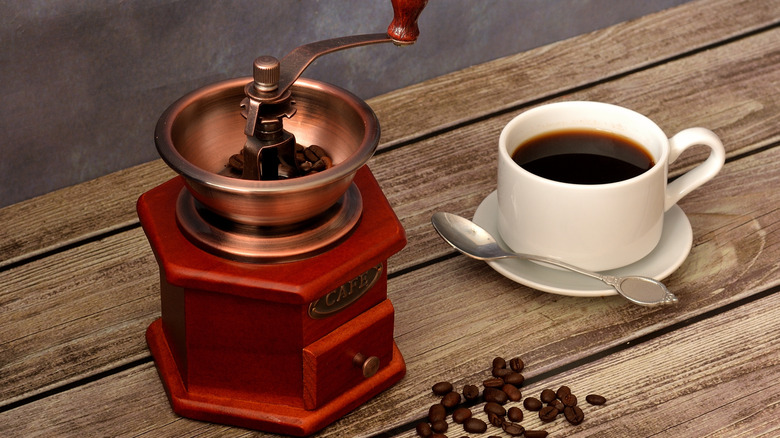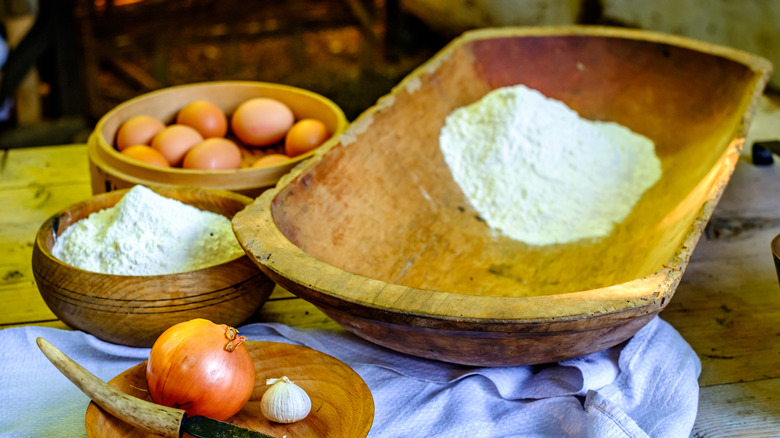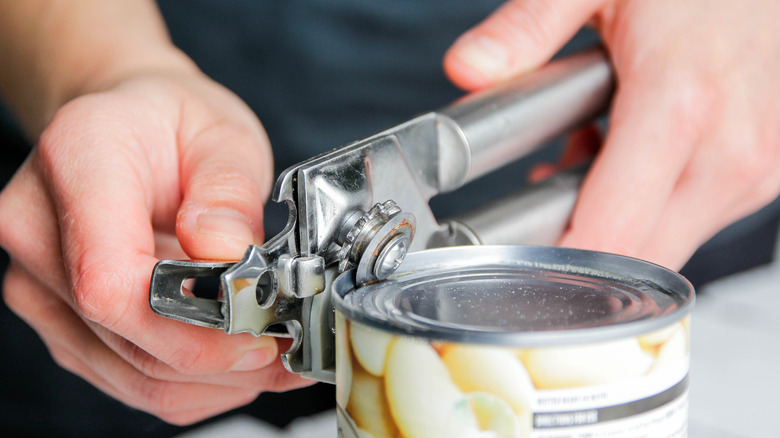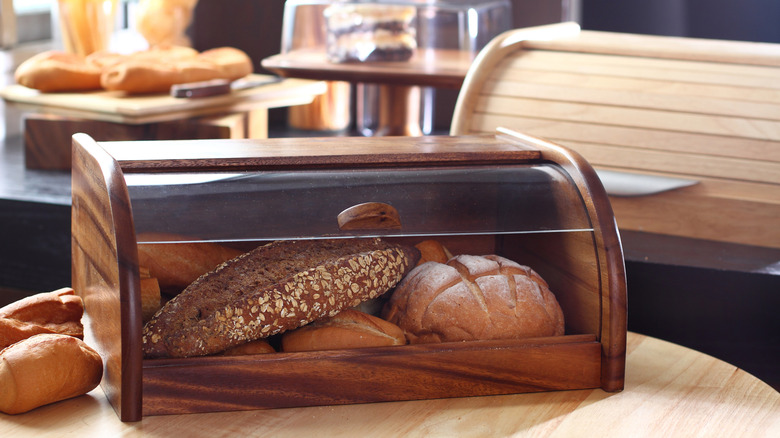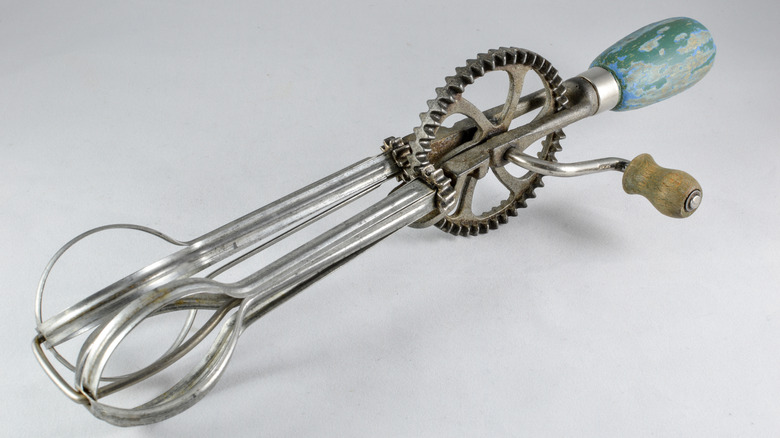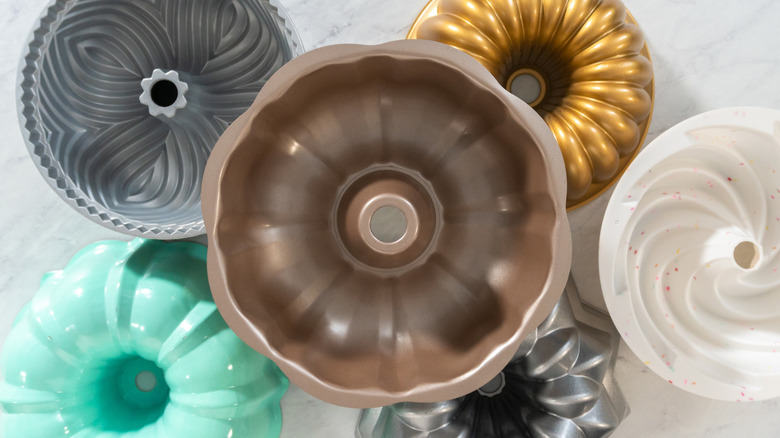9 Old-School Kitchen Tools That Still Hold Up Today
It's always tempting to purchase the latest and most interesting technology for your kitchen, whether it's a temperature-controlled smart mug or high-end nut milk maker. Yet more often than not, these flashy kitchen items are uncalled for, used only a handful of times before eventually finding their way to the back of the cabinet. While such innovative culinary devices are undeniably novel and impressive (and in some cases, fun), not every kitchen tool is something that needs to be improved upon. In many cases, simpler really is better.
Some classics are classics for a reason. While the latest culinary novelty might impress your dinner guests, there's a fair chance that you can do without it. Yes, the vintage version might take a little longer, but that extra time often comes with advantages you may be surprised to learn about. Besides that, old-school kitchen tools have a way of grounding our cooking and prep, making us feel more connected to the process and the countless thousands of home cooks who've used the same types of tools before us. Let's take a closer look at some of these traditional kitchen tools that have stood the test of time, remaining just as useful today as they did in the era they were invented.
Apple peeler
Apple parers (known today as apple peelers) date back to the colonial period when a good number of American colonists grew apples as a principal foodstuff, finding the fruit to be a dependable produce for food and drink throughout winter. While the best-looking apples went to the apple cellar and the damaged produce were turned into cider, the rest needed to be preserved — something that involved a lengthy process of coring and peeling. Such demands spurred the invention of the humble apple parer.
Instead of painfully flaying each fruit by hand, an apple parer could quickly peel the apples so they could be preserved in the form of applesauce or apple butter, saving days of time. All one needed to do was place the apple in the prongs, spin the crank, and watch the peeler scrape off the rind in long ribbon-like strands.
The first incarnations of the apple peeler date back to the late 18th century, although these machines were cumbersome, requiring an operator to sit atop a wood board and steady them. Manufactured versions started making their way to Americans in the 1800s, with more refined cast-iron designs. Even today, people find apple peelers incredibly useful, with devices spanning from electric versions to old-world manual machines. Antique replicas can still be bought at retailers like the Vermont Country Store and are helpful today for anyone looking to prep a bundle of apples for cobbler, pies, and applesauce, or even to make shoestring fries.
Butter crock
Whether you call it a butter crock or a butter bell, these old-fashioned kitchen tools are more than just decor items. They're the perfect way to ensure your butter is spreadably soft any time you use it — no refrigeration required. How is this black magic achieved? A butter crock is composed of a base part, in which you our a small amount of water. Atop this is a lid with an attached well (often shaped like a bell or cup) where the butter is placed, pressing it down to avoid air pockets.
Once the two combine, they create a water seal, keeping that golden brick of dairy at room temperature and shielding it from spoiling. Yes, the water must be changed frequently (every other day or so), but the result is worth it: rich, pliable butter at a moment's notice. Trust us, your morning toast will thank you. As long as you purchase good quality butter with a high-fat content, bacteria won't be an issue — even if you prefer your butter unsalted, which tends to go rancid much quicker at room temperature.
No one knows exactly how this ingenious kitchen tool came about, but the origins of the butter crock are believed to have been born in France sometime in the late 19th century. For this reason you'll also see this butter keeper sometimes referred to as a French butter dish. Those looking to pick one up can find these ceramic designs everywhere from online cooking retailers to artisanal designs via Etsy.
Mortar and pestle
While the mortar and pestle might seem to be the most ancient of all kitchen tools, it's also the most enduring. At more than 35,000 years old it still stands as a valuable apparatus in kitchens around the globe. As the most refined chefs will tell you, using a mortar and pestle to crush herbs, spices, and more will lead to superior chutneys, curry pastes, and especially fresh pesto.
How so? A bowl and pestle mashes plants instead of cutting them, more effectively releasing their intense oils, aromatics, and flavors into your recipe. While slicing and dicing might penetrate your garlic cloves and mince your stems, crushing them will unleash their full potential, leading to more robust creations. Yes, a food processor is less work, but these shortcuts have their drawbacks. These electric devices often generate heat, and heat destroys the essential oils in herbs, occasionally even making garlic taste more bitter.
The mortar and pestle as a culinary tool dates back millennia; it was used by ancient Romans and Egyptians for medicinal purposes as well as for grinding grains to make flour. Although at first glance it might seem obsolete today, these vessels are still alive and well in the kitchen, wielded by home cooks and high-end chefs to make dishes from cuisines all over the world.
Consider picking up one of these ancient artifacts to make your next tapenade or aioli. Chili paste and salsa are another exceptional use for this time-tested tool. Using a device that has been around since the Stone Age allows a deeper connection to your food through this slower, more mindful process; it connects us to the millions of culinary traditions that have come before us using this very same medium.
Manual coffee grinder
Before the advent of electricity, it was common practice to grind your coffee by hand. Yet few of us even consider this practice these days, despite the hand-turn coffee grinder being a superior tool. If you have a coffee grinder in your home it is likely an electric blade grinder, which can generate an inconsistent grind (not to mention wake up anyone still snoozing). There are also electric burr grinders, which come much larger, louder, and pricier. However, a hand-turn coffee grinder can provide you with a uniformly ground product with barely any noise.
Electric coffee grinders can heat up coffee beans, changing the flavor of the grounds. Manual grinders won't. Hand-grinding your coffee also gives you a greater sense of connection to your brew that pressing a button just can't provide. While the first coffee mills invented were large contraptions usually mounted to a wall, modern versions of manual grinders are much smaller and more inviting in appearance. Nostalgic-style coffee grinders can be bought at many retailers and specialty coffee shops. Some have glass bases, others are acrylic, plastic, stainless steel, or wood.
Wooden dough bowl
Now seen as little more than a decor item by many, wooden dough bowls were once a staple in the colonial era, passed down from generation to generation. These deep bowls allowed dough to rise before baking, protecting it from cold drafts of air. Wood was a favorable choice as the heat produced by the yeast could be held in the wood, helping the dough to rise evenly. It's a far stretch for most of us to realize the merit of such items when bread is now mass-produced outside of the home to be picked up at a moment's notice.
Yet for those willing to take the time to make their own bread, this tool is still a valuable commodity. Handmade dough bowls can still be bought today, often made by small companies that use dense woods like cherry. They require a good deal of care, including vinegar baths and regular treatments with mineral oil, just like with cutting boards.
There's undoubtedly been a large resurgence in making your own bread, allowing people to customize their loaves with select ingredients and craft preservative-free pastries. Using a dough bowl in the process is a fuss-free method to help dough rise on cold days. Bread dough rises best at 75 to 78 degrees Fahrenheit, which might be easy during the summer months, but much more of a challenge in the winter. While some choose to store bread atop a high shelf or on a heated dough rising mat to help it rise on chilly days, a bread bowl is a much simpler solution — and one with quite a heritage.
Manual can opener
A device first invented in the mid 1800s and refined in the 20th century, manual can openers continue to be useful kitchen utensils — and not just for doomsday preppers. It's hard to believe that the can opener was invented nearly 50 years after the can, but it was. Why's this? The can opener wasn't produced until thinner, steel cans began to take the place of thick, wrought iron ones (before then, these nearly quarter inch thick metal cans were opened by a hammer and chisel).
The first can opener was patented in America in 1858, used during the Civil War and in grocery stores, where clerks would open canned goods for shoppers. Yet this was a rough design that left cans with jagged metallic edges. The hand-crank design with teeth and a wheel most of us are familiar with was perfected in the 1920s and remains the basic design many continue to use today.
Modern versions of non-electric can openers range from kid-friendly designs with hidden blades to those with magnets to prevent the lids from falling in the can. Not only is this manual tool helpful when camping or when the power goes out, it's also smaller, more portable, and cheaper than its electric counterpart. It's also something to keep on hand if the zombie apocalypse ever does come to pass.
Bread box
A device once so common that some homes had them built into their cabinetry, bread boxes were necessary to stop bread from turning hard and stale. When bread is left out, the water molecules creep to the bread's surface, leaving the starch molecules to reform, rendering the bread tougher. This process happens even faster if you place fresh-baked bread in the fridge. Bread bins fell out of favor along with the rise of preservatives entering mass-produced bread and the placing of such loaves in their own plastic packaging.
Luckily, these old-school bread bins are seeing a resurgence, especially with people who like to pick up fresh loaves from local bakeries or farmers markets. If you're someone who adores baking your own bread or experimenting with artisanal buns from pricier sources, a bread box is a must-have addition to your kitchen or pantry, be it a classic wooden design or high-end stainless steel model.
Especially handy in the muggier months, these nifty containers not only keep bread from going stale, but they also keep moisture out in humid environments, preventing bread from molding. As a result, many a bread lover has found this to be a kitchen necessity that is here to stay. Some are even going as far as to have bread boxes custom-built into their kitchen cabinetry once more, blending this tried-and-true kitchen tool with contemporary designs.
Hand-crank mixer
Before the all-purpose stand mixer graced our kitchens, hand-crank mixers were a staple for folks to blend ingredients and beat egg whites. The first manual mixers date back to the mid-19th century, used in hotels and restaurants before making their way into the family home. Such devices made arduous undertakings like whipping egg whites into stiff peaks for soufflés and meringues much easier.
Still useful today, these man-powered tools give the user more control than an electric beater and take the same amount of time, with no need to untangle a cord or make room around an outlet. Despite what many assume, hand-operated mixers and rotary egg beaters are not tools of the past. You can find these nifty kitchen tools for affordable prices on Amazon and Wother online retailers, with more specialized outlets selling higher-end models.
They're less work than a whisk, and oftentimes less expensive than an electric stand mixer, so why not give one a go? Manual mixers will render extra fluffy scrambled eggs, airy cake batters, and churn out a side dish of whipped cream in less time than it would take to dredge your stand mixer out from the back cupboard (where it's likely gathering dust).
Bundt pan
Invented in 1950 by Nordic Ware cofounder David Dalquis, the aluminum Bundt pan was once found in nearly every home back in the day. Popularized by a cake that won second in the 1966 Pillsbury Bake-Off, Nordic Ware and Pillsbury soon joined forces to market cake mixes and Bundt pans, fueling the baking pan's rise. Dozens of other recipes came to use the pan in the '70s and '80s, from rum cakes and lemon bundt confections to the orange-glazed Harvey Wallbanger cake.
Never part of Nordic Ware's original product line, the arrival of the Bundt pan happened at the behest of a circle of Jewish women in Minneapolis who contacted Dalquis to see if he might craft a pan like those from Europe. Known as kugelhopf or bundkuchen pans, these were bulky pans with a cone in the center to quicken baking time, sometimes weighing as much as 15 pounds.
Dalquis improved on the design tremendously, using lighter cast aluminum. The Bundt pan has been produced ever since, although it was nearly discontinued in the 1960s before the Pillsbury Bake-Off made it a household name. The original Bundt pan is still sold by Nordic Ware, made in the U.S. from the aforementioned cast aluminum and equipped with a 10-year warranty. Consumers can also buy uniquely-shaped versions of the Bundt pan in intricate designs, from heart shapes to gingerbread houses. Although some see it as an old-timey kitchen item, innovative cooks are still using this vintage pan to do everything from cutting corn to roasting chicken, and of course, baking cakes (with some handy tricks to help remove them).

